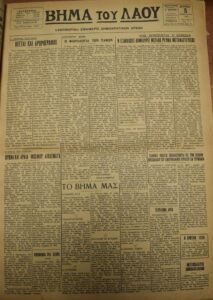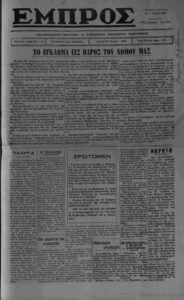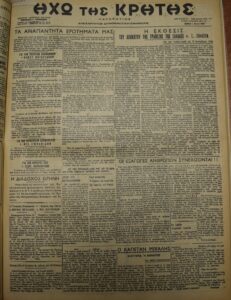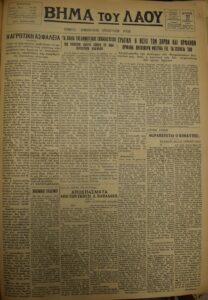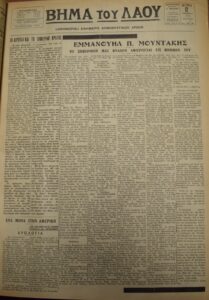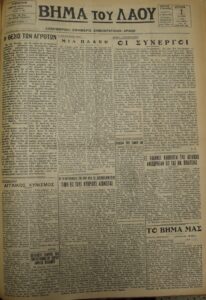How the Cretan Press covered the postwar migration wave
Full Description
The postwar period saw a major migration wave away from Crete to two main destinations: the capital and countries abroad.
The Cretan migration fits within the context of the wider postwar population movements, both internal and external, and was motivated by the same factors: the widespread destruction unleashed on the country during the 1940s; the poverty faced by the people, exacerbated by war; the nature of the Greek agrarian economy, which at best offered underemployment to the majority of the rural populations; the absence of large-scale industrial units, as most industries were at the time small family businesses; and the political asphyxiation people experienced in postwar Greece. As a result, a massive redistribution of population took place between 1950 and 1970, with about half the population of the country abandoning the places where they were born and moving to major Greek cities or abroad.
Of course, migration should not be seen as merely a personal choice of the people who moved. Research in migration has highlighted how population movements were a tool used by postwar Greek governments to resolve the issue of economic development in the country. According to A. Machaira, ‘During the 1950s and the 1960s, migration policy was firmly embedded within economic policy and migration was viewed through the lens of the country’s development goals. […] It became the preferred solution to the problem of unemployment and underemployment.’
An examination of Greek migration in relation to the economies of other countries of origin, as well as those of countries of destination, reveals the structural characteristic that draws migration to industrial societies: the inequality between agrarian and industrial countries, which pushes populations away from the former and towards the latter.
Mentions of some of these adverse conditions which were facing the average resident of the Cretan countryside at the time can be found in the postwar local press. Poverty and its exacerbation due to the absence of state support are criticised across a number of articles, especially during the 1950s. In just one indicative front page from 1950, we can find three relevant articles, one denouncing the problem of animal theft and how it affects farmers, the second decrying the operational issues faced by primary schools in the Municipality of Chania, and the third calling for immediate food distribution to the orphans who are not eligible for free meals. On the front page presented here from a pro-opposition newspaper in 1953, the problems of the Cretan farmers are depicted as part of a wider problem affecting agrarian populations all over Greece and a similar front page three years later indicates that the situation had not improved much.
Even though systematic external migration from Crete had not yet started in earnest, even as early as the beginning of the 1950s the local press published a few articles connecting migration with living conditions. When published in pro-opposition newspapers, the coverage is clearly a condemnation of the ruling party, as can be seen in the indicative article presented in this entry, published by a centrist newspaper in February 1954. Entitled ‘While the farce continues, deprivation creates a major migration wave’, the article blames Papagos’ conservative government not only of incompetence, but also of driving voters to the Left.
From the beginning of the 1960s onwards, references to migration in the Cretan press became more and more common. This shift is reflected in the front pages of the newspapers, despite the fact that Crete and the rest of the Greek islands accounted for only a small percentage of the total number of external migrants in the period 1955-1957. The harsh living conditions and the promotion of migration as a solution were strongly condemned. A newspaper from Rethymno wrote in 1964: ‘Mr. Papandreou committed a crime that will destroy and eradicate our Prefecture when, during his recent trip to Crete, he established INDUSTRIAL ZONES in Heraklion and Chania. [..] By creating industrial zones in neighbouring cities, he sentences our city to isolation and marginalisation. […] Our city is condemned to suffer the ravages of unemployment, our citizens are condemned to migrate to other cities.’
A Chania newspaper wrote in 1965: ‘The number of people migrating has gone up instead of dropping. […] It’s hard to communicate the pain felt by our editor when a few days ago he met on the street a farmer friend of his with his daughter, aged between 20 and 25. They were both very happy because they were coming from the Australian office in Chania, where the daughter had been examined by the committee (Australians, Greeks, the Provisional Intergovernmental Committee for the Movement of Migrants from Europe [the precursor to IOM], etc.) and had been found fit to travel to Australia.’ The article also provides some indicative migration figures for the years 1963-1964: ‘In 1964, 105,569 Greeks permanently migrated abroad. In 1963, the number was 100,072. Namely, 5,497 more Greeks migrated abroad. Of these external migrants, 5,134 in 1964 and 3,009 in 1963 were Cretans. Namely, 2,125 more Cretans migrated abroad.’
More than ten years later, a leftist newspaper of Heraklion denounced the lack of basic infrastructure in some areas of the island and linked this fact with migration: ‘The Settlement of Agios Ioannis in the village of Epano Vatheia, consisting of 26 people, does not have electricity. This is not a rarity, there are more settlements in Crete with no access to electric lighting, a basic necessity of civilisation. […] 1. Is this the way to reduce migration? 2. Is this the way to protect the Agrarian Economy? […] And what’s more, all 26 residents of the aforementioned settlement are Asia Minor refugees.’
Bibliography
Lina Venturas, Migration and Nation: Transformations of Collectivities and Social Positions, Society for the Study of Modern Hellenism – Mnimon, Athens 1994.
Nikitas Patiniotis, Dependence and Emigration: The Case of Greece, National Center of Social Research (ΕΚΚΕ), Athens 1990.
Anna Machaira, ‘Migration and economic development in postwar Greece. The centre-Left perspective’, Mnimon, no. 25 (2003), pp. 79-110.
Antonis Liakos, The Greek 20th century, Polis, 2019.
Hellenic Statistical Authority, Statistical Yearbook of Greece 1959, 1960, National Printing House, Athens.

